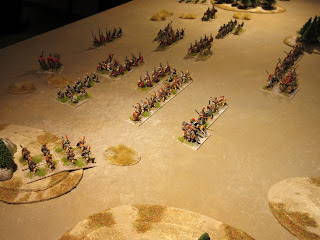Following the Second Punic War, Rome began a slow process of expanding its control over Hispania from its two provinces of Hispania Citerior and Hispania Ulterior. Both consuls pushed their respective frontiers further northward reaching the lands occupied by the Lusitanian and Celtiberian tribes.
Not all would acquiesce to Roman control and some like the Celtiberian would require a large-scale effort to bring them to heel. For the upcoming campaign. the senate extended the command of Lucius Postumius Albinus and Tiberius Gracchus for another year. Albinus would move against the Vaccaei before meeting Gracchus in Celtiberia. Meanwhile Gracchus focused his sights on Munda as his first objective. Munda fell, as did many other cities, but as Livy notes, many that capitulated were made in bad faith as the departure of Gracchus signalled the resumption of hostilities.
In 179 BC, two sharp engagements took place near Mons Chaunus and serve as an inspiration for the following games. The first battle brings the vanguard of Gracchus in contact with the Celtiberian culminating to a decisive battle three days later. For this simulation, the first battle is played as a standard game of twelve elements finally doubling in size as the vanguard joins with the main body. Rome will have a single command of 24 elements to face two Celtiberian commands of 12 elements each, minus the respective losses incurred in the first engagement.
Battle
near Mons Chaunus
Like spectres
rising up from the earth, the Celtiberians broke from cover to surprise the
legion. Scrambling to form line from march column, the proconsul ordered the
Latin auxiliaries to secure the high ground to either side of the pass while
the legion formed for battle.
It did not
take long for the Celtiberian to sweep the hill clear of Latin defenders on the
left flank. On completion of the first phase, the Celtiberian scutarii moved
toward the legion.
Having lost
the high ground on the left, the proconsul would not move the legion forward
until the situation on the flanks was rectified. Latin auxilia and velites sent
back to recover the heights and the timely arrival of the triarii improved the
situation on the left.
Despite the
Celtiberian advantage of the high ground, the Roman continued to hold its
position on both flanks and centre. Now fully engaged, the lines of
legionnaires and scutarii swayed back and forth with neither side breaking.
On the left, the Latin auxiliaries gained the heights and turn the tide forcing the Celtiberian to break off battle (4 – 2).
Game notes; losses remain lost for the subsequent battle.
Three
days later…
Gracchus
deployed the combined force with legions in centre, on the right, Latin
auxiliaries were positioned on the foothills of Mons Chaunus and on the left
near the woods were the Latin auxilia of the vanguard.
The Celtiberians placed their strongest tribe on the left to meet Gracchus leaving the smaller tribe to meet their previous day’s combatants. Intent on securing the heights on Gracchus’s right, the Celtiberian warlord sent all his caetrati which easily secured the heights. This done, the scutarii of both tribes made a rapid advance toward the awaiting legions.
Both
legions were fully engaged and taking severe loses. Adding further discomfort,
Celtiberian light horse had circled the Roman rear to engage the Latin cavalry.
The Latin cavalry bolted leaving the triarii to face the new threat.
The situation became desperate for Rome as gaps in the line were quickly filled with enemy scutarii. Despite the heavy losses (6 – 1), Gracchus regained control of the situation by moving fresh units including his personal bodyguard. That change brought a glimmer of hope as the enemy were beginning to falter (6 – 4).
Having
suffered defeat three days earlier, the smaller Celtiberian tribe broke. Seeing
their right flank collapse and incurring further casualties among their own
tribesmen, they too joined the general retreat leaving a thankful Gracchus to
hold the field (6 - 7).
Game notes.
From Livy’s
description, the first engagement takes place near a pass in the mountain
chain. The Roman player deploys first giving the Celtiberians a slight
advantage by deploying second. Three difficult hills are placed on the board as
seen in the first photo.
The second battle brings together all Rome’s forces (minus losses of the vanguard) under one command, e.g., one die. The Celtiberian differ as they field two separate commands one of which have lost troops from the previous engagement. One die for each command might seem an unfair advantage, but this is compensated by the lower break-point for each Celtiberian command. The terrain consists of three difficult hills forming a mountainous range on one side (Mons Chaunus) and two woods on the opposite side. The scatter material is optional, but looks good.










No comments:
Post a Comment